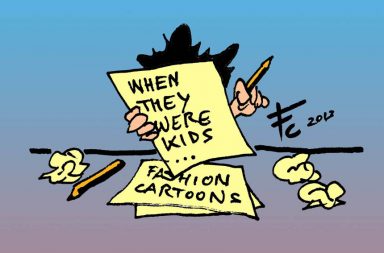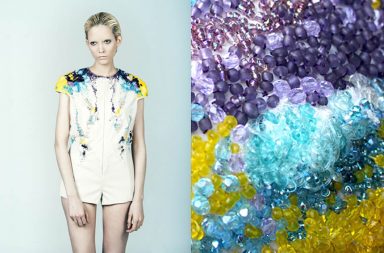A little over two years ago we interviewed Sol Pardo after her collaboration with designer Lautaro Amadeo, the winner of FashionClash Maastricht 2015. Since then, her work has been shown in a number of magazines, including Harper’s Bazaar who named him best accessories designer of 2015.

We’re checking in again with Sol Pardo after the recent launch of ‘Albino’, an impressive collection where modernity and synthetic materials blend with the classic tradition of Greenpacha’s Panama Hats, a California-based company that makes hats with traditional materials (straw) in Ecuador.
Sol Pardo is returning to Barcelona, the city she knows and loves from where she plans to direct new projects and grow her label, Pardo Hats, and we’re sure that the sky is the limit.

From So Catchy! Where Fashion Begins, we wish you the best of luck, you deserve it!

SO CATCHY!: We last talked two years ago. What have you been up to since then? How has your life changed?
SOL PARDO: I still identify as a young designer. From project to project I always find new paths to take. Every day I’m more interested in the underlying ideological content of the collections I’m working on. I don’t think it’s enough to just develop a compositionally beautiful, harmonic and agreeable image. More than just looking for beauty and shapes, I find myself respecting the intuition that leads me to intention, in my role as a designer, to create a conversation about ‘a better world’ and to evoke possible scenarios where social aspects, the concept of Latin America, sustainability, slow-fashion and the resignification of the profession are present.

SC!: When we last talked, you were about to present your thesis. Can you tell us a bit about it?
SP: The title was ‘Hypermodern Narcissus, objects carried on the head’. In it, I talked about the need of modern-day individuals to beautify our faces and to exhibit them through modern, expansive channel, just look at selfies, and the importance of consuming exclusively designed products where the subject who wears them, the client, has an affective, psychological and individual link with the item to be designed, and with the designer, with the end goal of not throwing the piece away once ‘consumed’.
I received recognition from the University of Palermo for ‘Best graduation project’ and I now have two degrees in design, together with two good friends.

SC!: We know you’re moving back to Barcelona. Why did you choose that city, and do you plan to set up a workshop there?
SP: When I finished my second university degree, I wanted to do a postgraduate studies, maybe a Master’s, so I signed up online for a scholarship with the Argentine National Foundatio of the Arts and thought no more of it. In the end, though, I was selected and the scholarship allowed me to choose anywhere in the world to go study. As Barcelona has always been a second home for me, I chose to go there. I visited some of the universities and selected the IDEP, mostly because of a talk that the director of the fashion school gave. Vilda Ángel, the designer behind Brain&Beas, will be leading my training and I hope to set up PARDO Hats as a sort of an international laboratory label for millinery.

SC!: What projects are you working for the future?
SP: My future project is to achieve a level of recognition in Europe similar to the reputation I have obtained in Latin America.
I also intend to set up a small millinery workshop so that I have a space to receive private clients and to continue producing future capsule collections for Pardo Hats.
I will also be working as part of the creative team for GREENPACHA, a small, up-and-coming millinery label based out of California that is dedicated to producing the famous Panama Hats, hats handmade with toquilla straw by weavers in Ecuador.
Greenpacha and I share the same dream, creating links and working with indigenous communities, appealing to the resignification of the Panama Hat, with the goal of fighting for a more united Latin America, that takes care of it’s natural resources, and is part of what we believe can be a better world. So I’ll be travelling a bit to California, to Ecuador or to wherever necessary to achieve our objectives.

SC!: What do feel has been your biggest success up to now?
SP: Probably the year I spent working with communities in Ecuador for Greenpacha. I could see how my simple designs could give new meaning to something already established and could generate so much emotion and happiness. I found myself in very humble areas, where the locals offered me everything in exchange for nothing. You can’t put a price on that. Buenos Aires is like a migratory bubble, all of my relatives have European roots, Italian and Spanish, and I had always felt more closely linked to those cultures, but always with a certain sense of alienation which was linked to political problems in the region. Seeing the unfortunate political situation that my country finds itself in, I can see how important it is to leave the region to be able to truly talk about it. In summary, my greatest success has been to realize that there are ways to collaborate with others, even as a young designer.

SC!: Your latest collection, Albino, can you tell us about it?
SP: Conceptually, I’ve always been interested in different canons of beauty, and my university had a student who was Albino. I got in touch with him and told him that I wanted to do a collection with him as the inspiration, and he agreed. After talking with different professionals, we decided to make a ‘fashion film documentary’ that proposed all of the ideals that move me as a designer.
As for design, I haven’t been able to make hats without acrylics, but while searching for materials I thought that the crown should be made of straw, which led me to the famous ‘Panama Hat’. I got in touch with Greenpacha to purchase some of their materials, told them about the project and they asked to take part. When I had finished, they invited me to Ecuador to see the manufacturing process. It was there that I realized how relatively little innovation exists with that material. Nobody before had worked with straw to modify the material in such a way as we had and we were even asked to show the hats by a museum.
Some months later and I’m working with them as a designer, and finishing up a project for Pardo Hats called ‘Vitiligo’, which I hope to have out in a few months.

SC!: Do you sell online? How can we get our hands on one of your hats?
SP: I’m actually quite jealous of people who have my hats. In general, people who become my clients find me, either through Instagram or by e-mail. I think that’s a part of slow fashion, and it’s how I work best. With the millinery that I do, the hats are unique pieces. So when people get in touch to buy a hat from one of my collections, I usually convince them to make one specific to them, with a mix of their identity and mine. I study them, we visit or send e-mails with measurements, color palettes, textures, etc. I give an approximate time for delivery, according to the demand, and I send it off. For the moment, nobody has sent one back!
SC!: We can tell that you enjoy working on fashion films. What do you think you bring to the genre?
SP: I believe I am a frustrated film director! Through fashion films I discovered a new way of telling tales, of creating deeper stories. For me, a fashion film is just about showing off hats, it’s about showing the identity of the work that I do with PARDO Hats. Knowing where a piece will be displayed is a fundamental part of planning a collection, as well as knowing who will wear it, what music will be playing, etc. I look at it as another part of the whole collection. It’s as important, or more, than the hats themselves.

SC!: Where do you look for inspiration?
SP: Science or Art museums, cult films, human behavior, the immensity of nature and my affectional bonds, which are always there whether you recognize it or not.

SC!: Websites or Instagram accounts that inspire you…
SP: There are thousands, but the ones that come to mind now are @melaniegaydos, @louisrubi, @rottingdeanbazaar, @domestic_jewelry, @valemarossa, @hatterist.

CREDITS:
Photography: @williamkano William Kano Asistente
Photo assistant: @milimelzi Milagros Melzi
He:@dery_altamira Dery Altamira
Creative direction: @bysolpardo
Styling:@bellamorosi Belen Amorosi
Hats: @pardohats in collaboration with @greenpach.
Styling Assistant: @chicodesombrero Sergio Docarmo Crias
Design assistant: @laraortegadesio Lara Ortega Desio & @carolage Carola Lage
Graphic Design: @andresestrada89 Andres Estrada
Product Photos: Oscar Sanhueza Chesta
Translation & Layout by Michael Padilla




